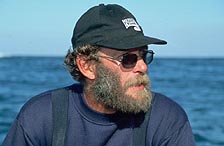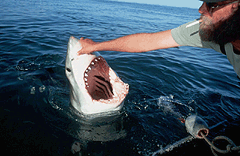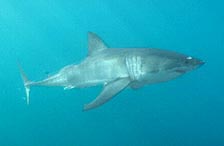|
The
most frightening of all sharks is worthwhile a test of
courage. An outstanding experience in South Africa. Text
and photos by Jerome
Konen
(Trip from 9 - 23 June 2001)
A dorsal fin of a Great White is cutting through the smooth
surface of the sea and is heading fast for the stern of our
boat, so in the rush of the action, I'm quickly adjusting my
camera settings, bending myself over the outboard motor to get
as close as possible to the water surface. I can see the
shark's frightening deep black eyes showing close through the
water surface and before he snaps the bait, André, our
tour guide, takes him with his fingers by the nose and gets
the shark breaking through the water, the mouth wide open. I
caught my breath, while shooting some photos at half a meter
close right into the mouth of the shark. This has finally been
the scene I was dreaming about long before I came for this
trip to South Africa.
Best Region for Shark Diving
Here in Gansbaai, about 150 km east of Cape Town, the
southernmost part of South Africa, is probably the best region
worldwide to see Great White Sharks and to dive with them,
well protected by a cage. André Hartman, our guide, is
since more than six year in this business and has developed a
good feeling for these animals. His experience tells him where
he has to search them depending on the current and the
visibility under water.
| Interview |
| |
 André
Hartman is a rough and courageous guy. He is in the
business as a tour guide since several years where he
gets the sharks to open their mouth and guides them like
a puppet player. But he considers himself still learning
everyday about the behaviour of the sharks. André
Hartman is a rough and courageous guy. He is in the
business as a tour guide since several years where he
gets the sharks to open their mouth and guides them like
a puppet player. But he considers himself still learning
everyday about the behaviour of the sharks.
J.K.:
How do you estimate the danger when you go free diving
with the Great White Shark without protection by a cage?
A.H.:
Opening and closing his mouth is the only reliable sign
of the shark before attacking. Then give him a hit on
his nose and he will be disturbed and turn away. Best is
to use a ski stick for your defence. The shark normally
considers the diver as another animal searching for the
same prey. But I can't assure this works everytime.
J.K.:
How do you explain the hesitation of the shark before he
catches the bait?
A.H.: The shark has no
territory claims, so before he feeds, he investigates
first the bait and the complete underwater environment,
like circling around the boat and the cage, then he
returns back to the bait to catch it. As he has a very
short memory, when he's back later, he starts
investigating again. But blood in the water makes the
sharks very nervous and there is no hesitation anymore
during feeding.
J.K.: There seams to be an
order of precedence among several sharks while feeding?
A.H.:
When a big shark comes into the scenery, he makes his
position clear to the smaller ones, those leave the bait
to the bigger shark and give him some respect.
J.K.:
What may be the reason the shark is giving no reaction
when grabbing his fins?
A.H.: The Great White
Shark has probably no sensation in the top part of his
fins. This may explain the lack of reaction when you
grab the fins with your fingers.
|
|
 |
|
The Usual Prey
Some time ago, Gansbaai was still a small fishing village
with a habour, fish cannery, a few shops and pubs, but since a
few years several White Shark Tour Operators have been
etablished here. They take you out with small boats to a
island close to the shore called "Dyer Island", a
barren, flat rock where countless birds are breeding. Besides
is the small "Gyser Rock", a island occupied by
about 30.000 seals. This extensive colony of seals is the
usual prey for the White Sharks here. Scientists have found
out that the White Sharks are moving from Namibia along the
South African coast to Mozambique and further to Tansania and
back again. Some tagged animals have even been sighted in
Australia.
Waiting for the Sharks
Sometimes it takes one or two hours before the first shark
appears on the bait. In order to lure the shark to the boat, a
net bag is filled with shark liver from fish offal called "chum"
and put in the water at the stern of the small boat. This will
stimulate their sense of smell. In addition a rubber seal
dummy on a lead takes the white shark close to the boat where
the lay out bait should make the shark feeding.
Getting into the Cage
The shark is still around the boat and takes constantly a
snap at the bait. Now the time has come to enter the cage. The
dry suit is the best protection against the 15°C cold
water. Quickly I have to buckle the 16kg weight belt, than
comes the most unsecure moment, entering the cage from the
deck rail of the boat. Should I have now my arms or legs
outside the cage, then an attack by the white shark isn't
excluded.
Graceful Appearence
Done, I'm safe in the cage now, in that moment the shark
puts his head through the barred frame. My adrenalin level
shots up but seconds later the shark turns away again. I gasp
for air through the regulator and I try to concentrate now for
shooting pictures although the cage is moving quite a lot in
the waves. Only underwater you get really conscious about the
graceful appearence of that predator having a 400 million
years of evolution behind.
| The Great White Shark |
 |
Size: At birth 100
- 150 cm, mature females 4 - 6.5 m, mature males 2.4 -
5.5 m.
Dissemination: Worldwide in
the coastal waters of most temperate and a few tropic
regions.
Usual prey: Seals and other
sea mammals, various fish species, sea turtles, other
sharks and rays.
|
|
As the shark isn't that aggressive to the divers being
inside the cage, I asked André at the surface to pull
the bait closer to the cage, so that I would have the shark
trying to feed pretty close to my camera. Best for taking
pictures is having the animal less than one meter close to the
lens. This let me shooting the most impressive part of the
Great White Shark, the open mouth including it's frightning
teeth.
The Shark's Fingerprint
Typical characteristics of the White Shark is his tapering
muzzle and his deep black eyes without visible pupils which
may turn back at the moment of biting. He is only white
colored on the belly side, the back and flanks are in
different shades of grey. A reliable distinguishing mark is
the horizontal transition in grey shades between the head and
the gill slits, as it were the shark's fingerprint.
No Primitive Species
During all these encounters with the Great White Shark I
have learned above all that this so feared animal is not a
primitive and voracious species but may also be cautious and
reserved in his environment. Most of the time the shark tries
some tentative attempts at the bait, keeps turning around the
boat and the cage, so like he memorizes everything before he
snaps at the bait. But if you add blood into the water, the
shark gets very nervous, his movements speed up and he bites
at the bait immediately. |